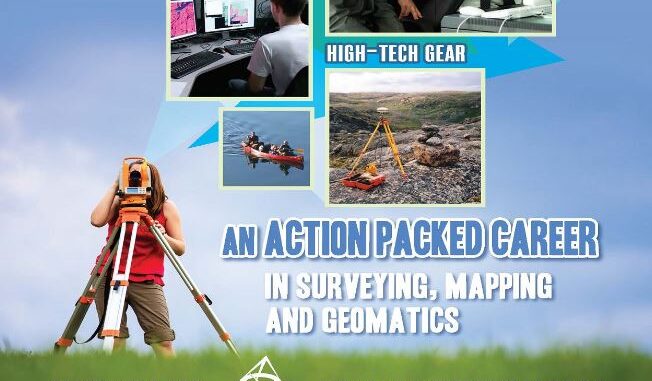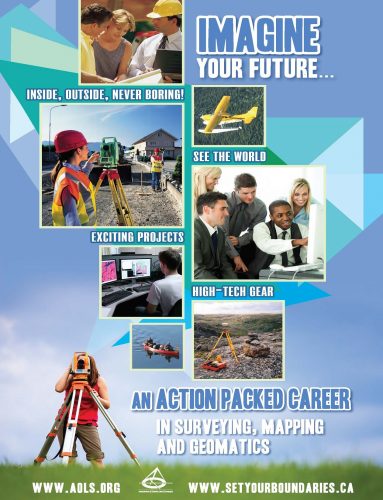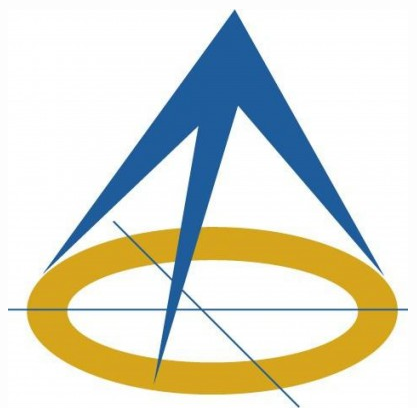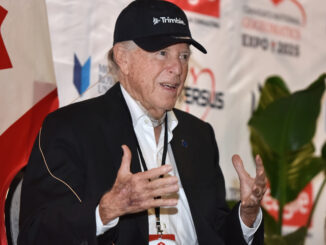
There is much about land surveying that is not known by people outside of the profession. Prospects for life-long careers in land surveying are exciting, especially when people become aware of the nature of the work, salaries, and the technology used today and planned for tomorrow.
It began in Canada with the arrival of Champlain
Samuel de Champlain, the first surveyor in Canada, was followed by legions more from France and Great Britain to map the St. Lawrence, and Upper and Lower Canada for military settlements, treaties, trade routes, and private landholdings. Many surveyors stayed in the communities they surveyed, planning subdivisions, and owning grist and sawmills. They were among Canada’s first entrepreneurs.
Little has changed in the demand for land surveying and what we now know as “geomatics,” since Champlain’s arrival in the early 1600s. Many surveyors are now legendary yet remain unknown in the development of the provinces and Canada. History has been kind to the profession and the works of surveyors are recorded in detail for all time.
What is Geomatics and how it is related to Land Surveying?
The term “geomatics” was created at Laval University in the early 1980s, based on the concept that the increasing potential of electronic computing was revolutionizing surveys and representation sciences – and that the use of computerized design (video diagram) was compatible with the treatment of huge amounts of data. That period’s revolutionary intuition was based on the geographical location of each object on our planet.[1] Nowadays, the term is widely used and often considered vague by some to describe the many specialties of “surveying” that are evolving through the application of innovative technology.
Why are there career opportunities?
The Association of Ontario Land Surveyors (AOLS) and its members are governed under the Surveyors Act to protect the interests of the public. The AOLS has seen a significant decline in membership over the last decade and is taking action to ensure that the public has access to professional surveyors. Over 60% of members are over the age of 50.
Where do surveyors work?
Surveyors are employed in private industry and various levels of government (municipal, provincial, and federal). The skills and knowledge of land surveyors are transferable to any part of Canada and abroad.
The AOLS describes the activities of a geomatics professional in the following ways:
- Everyday use of applied geography, engineering, science, physics, computer programming, and mathematics
- Investigative reporting and mapping
- Dispute resolution among property owners
- Forensic science investigations
- Application of the latest technology for data collection and mapping
- Opening new frontiers of knowledge through information and data collection
- A wide range of workplace environments throughout Canada and abroad
- Travel and work platforms that include aircraft, marine vessels, and terrain vehicles of all description
- A career that allows you to grow professionally and personally while building wealth, and
- A full and rewarding life-long career
There are not enough licenced and specially trained professionals and technologists to carry out the demand for the activities of geomatics professionals.
So, where’s the evidence of demand and a life-long career in geomatics?
There are five branches of geomatics recognized by the AOLS. Cadastral (boundary) surveying is a licenced activity and only an O.L.S. can legally engage in cadastral surveying. The four other branches where members of the AOLS provide services with a Certificate of Registration are Geographic Information Management; Geodetic, Photogrammetric; and Hydrographic. The demand for land information professionals and technical staff is high and is expected to increase. Geomatics careers continue to grow in geospatial mapping, location-based services, navigation, remote sensing, natural resources management, energy, mining, hydrography, urban and rural planning, environmental management, land and engineering surveying, marketing, satellite positioning, digital mapping, image analysis, information management and transportation.
Periodically, the AOLS surveys its members employed in the private and public sectors to document various aspects of the profession for growing the profession, sharing information about salaries, industry standards for working as a geomatics professional, and among others, continuing education. Here are the facts:
- Threats, or risks for surveyors include the availability of skilled workers and technologists; lack of geomatics graduates; and lack of knowledge and skills of new surveyors
- Opportunities for surveyors include broader geospatial services (GIS, remote data collection); use of and provision of modern technology; cadastral surveying; and capitalizing on the decreasing number of surveyors
- When it comes to having enough qualified staff, 73% of enterprises with a Certificate of Authorization cannot find enough qualified technical staff, and 68% of AOLS members feel the same way
- Most members of the AOLS hold a licence; others hold a Certificate of Registration (Geographic Information Management; Geodesy, Photogrammetry; and Hydrography)
- Currently, there are over 100 people (male and female) who have graduated with a four-year degree accepted by the AOLS and now employed and articling with a supervising O.L.S. to obtain a minimum of 1-1/2 years of practical training and work experience before passing an examination covering current Ontario Statutes relevant to the profession, several written professional examinations, and an oral examination before a panel AOLS members
- A salary survey in 2020 of technical staff suggests that people with technical job descriptions in a firm with less than five technical staff earn a median salary ranging from $20-$30 per hour; median salaries for firms with 5-10 technical staff range from $21-$30 per hour; median salaries for firms with 11-20 technical staff range from $20-$35 per hour; and median salaries for firms with over 20 technical staff range from $20-$39 per hour
- The average experience of field staff ranges from 5 to 20 years
- Most people who start as field staff have limited surveying experience
- On average, field staff are graduates of a college program, some in programs related to surveying and others from a survey program
- The average experience of office staff ranges from 5 to 20 years
- Office staff tend to be college graduates in a related program or college graduates in a surveying program
- Most people who start as office staff have limited surveying, drafting, and calculating experience
- On average, office staff are graduates of a college program, some in programs related to surveying and others from a survey program
- An employment survey of professional members in 2018 found that articling students earn a median salary of $58,000; members working with a certificate of Registration had a median salary of $128,000; licensed members in the private sector has a median salary of $130,000; and licensed members in the public sector had a median salary of $105,000
- Median salaries do vary a little throughout Ontario
The pitch
Geomatics professionals who are members of the Association of Ontario Land Surveyors earn a good stable income throughout careers that can last well into their 70s, although the greatest number plan to retire between ages 60 and 65. Most become licensed or registered in their 20s. If geomatics professionals plan to retire between ages 60 and 65, they have significant wealth and resources by that age to carry them through retirement that could last 25-30 years in Canada.
It is not hard to begin a career in geomatics/land surveying. High school graduates are hired for field and office work. Most office and field staff are graduates of college programs and they earn very good wages working with modern technology and safe working conditions both in the office and outdoors. Employers in the public and private sector cannot find enough high school and college graduates to fill the jobs that are available. Employers, through necessity are willing to train new employees.
People looking for professional careers in geomatics have many choices. If they wish to have careers as a licenced or registered surveyor with the AOLS, they can expect a career that can take them through government agencies or private sector enterprises where they have opportunity to own a geomatics practice.
As it was when Champlain travelled the St. Lawrence River and Great Lakes for the first time, the need for land surveyors and now geomatics professionals has not diminished on Crown and Provincial lands. Exploration and surveying were a lifestyle for Champlain. Modern surveyors enjoy lifelong careers advancing the collection of data and application of technology to create the fabric of our society. Its your choice. For details go to www.aols.org.
For current career opportunities in Ontario and across Canada, check out the two job boards below:
Association of Ontario Land Surveyors Employment Opportunities
AOLS has a page on its website to connect people seeking employment in the land surveying/geomatics industry. Check it out at www.aols.org/resources/public-resources/employment-opportunities
Professional Surveyors Canada Job Board
Since GoGeomatics is nationwide, take a look at the PSC careers page on its website at www.psc-gpc.ca/a-career-as-a-professional-surveyor/job-bank/find-a-job/
[1] Basics of geomatics, (Springer, ISBN 978-1-4020-9013-4); https://link.springer.com/article/10.1007/s12518-010-0029-6#:~:text=The%20term%20geomatics%20was%20created,treatment%20of%20huge%20amounts%20of






Be the first to comment